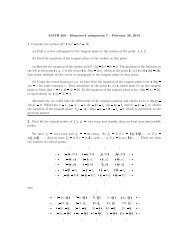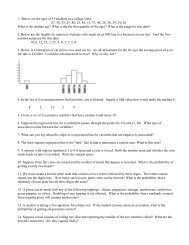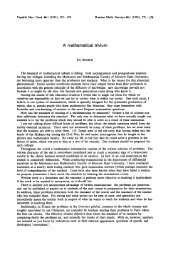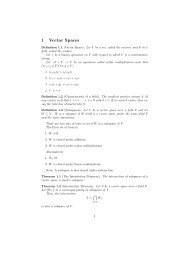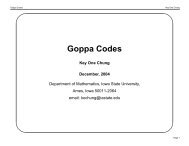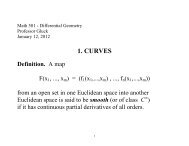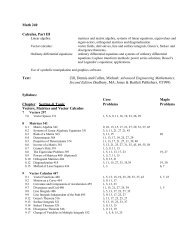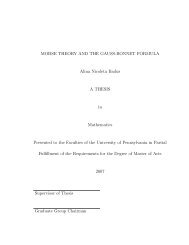Barcodes - Department of Mathematics
Barcodes - Department of Mathematics
Barcodes - Department of Mathematics
Create successful ePaper yourself
Turn your PDF publications into a flip-book with our unique Google optimized e-Paper software.
14 ROBERT GHRIST<br />
Figure 9. A Klein bottle embeds naturally in the parameter space<br />
as a completion <strong>of</strong> the 3-circle model. In the unfolded identification<br />
space shown, the primary circle wraps around the horizontal<br />
axis twice. The two secondary circles each wrap around the vertical<br />
axis once (note: the circle on the extreme left and right are<br />
glued together with opposite orientation). Each secondary circle<br />
intersects the primary circle twice.<br />
[5] G. Carlsson, A. Zomorodian, A. Collins, and L. Guibas, “Persistence barcodes for shapes,”<br />
Intl. J. Shape Modeling, 11 (2005), 149-187.<br />
[6] F. Chazal and A. Lieutier, “Weak feature size and persistent homology: computing homology<br />
<strong>of</strong> solids in R n from noisy data samples,” in Proc. 21st Sympos. Comput. Geom. (2005).<br />
[7] D. Cohen-Steiner, H. Edelsbrunner and J. Harer, “Stability <strong>of</strong> persistence diagrams,” in Proc.<br />
21st Sympos. Comput. Geom. (2005), 263–271.<br />
[8] V. de Silva, “A weak definition <strong>of</strong> Delaunay triangulation,” preprint (2003).<br />
[9] V. de Silva and G. Carlsson. “Topological estimation using witness complexes,” in SPBG04<br />
Symposium on Point-Based Graphics (2004), 157-166.<br />
[10] V. de Silva and R. Ghrist, “Coverage in sensor networks via persistent homology,” to appear,<br />
Alg. & Geom. Topology (2006).<br />
[11] V. de Silva and P. Perry, PLEX home page, http://math.stanford.edu/comptop/programs/plex/



